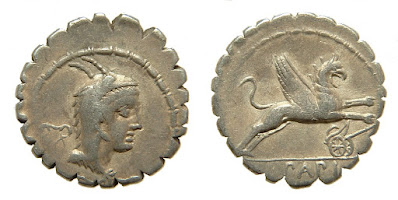The ancient city of Kolophon (sometimes spelt Colophon in the literature), is located in Ionia, Asia Minor. The ruins are situated to the south of the Turkish town of Degirmendere.
The standard reference work for the ancient coins was published by J G Milne in 1941, (Kolophon and its coinage: a study, American Numismatic Society Numismatic Notes and Monographs 96). The publication date betrays the difficulties in academic pursuit and this is noted by the author in the introduction. He says that:
“Before the interruption of international relations in Europe, I was collecting material for a monograph on the coinage of Kolophon: it seems improbable that I shall be able to complete it on the original plan; but it may be worth while to put on record the facts ascertained and the conclusions they suggest”.
I happened to be leafing through a 1990s Spinks Numismatic Circular report on a parcel of Ionia fractional silver coins and a Kolophon piece was the subject of a reattribution.
The type in question is a silver fraction, a hemiobol, features a right facing head described as being of Artemis on the obverse, Milne considering it to have feminine features. On the reverse there is a shallow incuse quadripartite square with a pellet in the centre. Milne lists it as a type from Kolophon from after 490 BC, number 18 in his catalogue.
The Spink paper cites a later reference that questions the Kolophon origin. Colin Kraay, in a 1962 Schweizer Numismaticshe Rundschau paper (Monnaies provenant du site de Colophon), suggests an alternative, possibly Magnesia ad Maeandrum. He puts forward the alternative based on the uncertainty of the head on the obverse, preferring an identification of it as being male and that of Apollo. He also believes that the type is too abundantly encountered for the relative unimportance of Kolophon at the time. He therefore suggests that Magnesia ad Maeandrum may be the more likely origin of the type, particularly as the city is known to have used an image of Apollo on the later coins issued by Thermistocles, c. 460 BC.
This is the difficulty when there is no city ethnic. Attributions have to be made based on criteria such as find location and continuity of themes in the design.






















